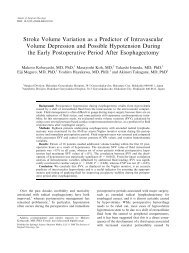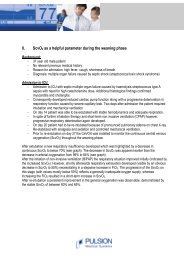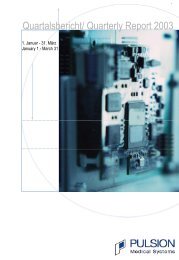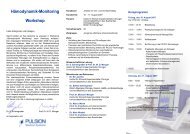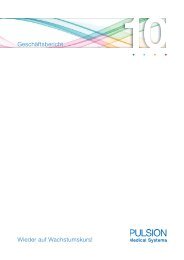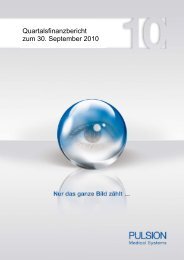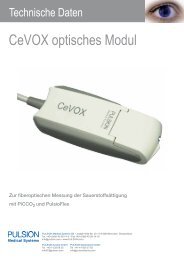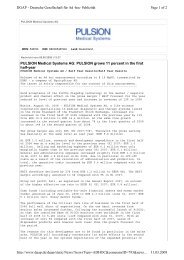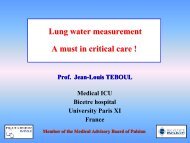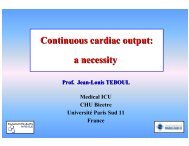The new england journal of medicine - PULSION Medical Systems SE
The new england journal of medicine - PULSION Medical Systems SE
The new england journal of medicine - PULSION Medical Systems SE
You also want an ePaper? Increase the reach of your titles
YUMPU automatically turns print PDFs into web optimized ePapers that Google loves.
pulmonary-artery or central venous catheter therapy for lung injury<br />
continued for seven days or until 12 hours after the<br />
patient was able to breathe without assistance. 42<br />
<strong>The</strong> PAC could be replaced by a CVC if hemodynamic<br />
stability (defined by the absence <strong>of</strong> the<br />
need for protocol-directed interventions for more<br />
than 24 hours) was achieved after day 3. We recorded<br />
complications from all central catheters<br />
present during the hemodynamic-management period<br />
and for three days after their removal. For<br />
the purposes <strong>of</strong> tracking complications, each introducer,<br />
PAC, and CVC was considered a separate<br />
catheter. We monitored compliance with protocol<br />
instructions twice each day: once during a<br />
morning reference period and again at a randomly<br />
selected time. A 100 percent audit <strong>of</strong> all instructions<br />
conducted after the first 82 patients were<br />
enrolled showed rates <strong>of</strong> protocol compliance similar<br />
to those obtained during the random checks<br />
(data not shown).<br />
All study personnel underwent extensive training<br />
in the conduct <strong>of</strong> the protocol and the measurement<br />
<strong>of</strong> vascular pressure. <strong>The</strong>y subsequently<br />
explained the study procedures to clinicians in<br />
the intensive care unit (ICU). Vascular pressures<br />
were measured in supine patients at end expiration;<br />
end expiration was identified with the use <strong>of</strong><br />
an airway-pressure signal, but the vascular pressures<br />
used in the protocol were not adjusted for<br />
airway pressure. 43 Four main protocol variables<br />
were measured at least every four hours. Blood<br />
pressure and urinary output guided management<br />
in both groups. Pulmonary-artery–occlusion pressure<br />
and the cardiac index were included in the<br />
protocol in the PAC group, whereas central venous<br />
pressure and clinical assessment <strong>of</strong> circulatory<br />
effectiveness (i.e., skin temperature, appearance<br />
<strong>of</strong> the skin, and the rate <strong>of</strong> capillary refilling)<br />
were used in the CVC group. Lactate levels, the<br />
rate <strong>of</strong> oxygen delivery, and mixed venous and superior<br />
vena caval oxygen saturation were not used<br />
as protocol variables. Prompt reversal <strong>of</strong> hypotension,<br />
oliguria, and ineffective circulation was the<br />
overriding goal <strong>of</strong> the protocol. <strong>The</strong> treatment <strong>of</strong><br />
patients in shock (defined by a mean systemic arterial<br />
pressure <strong>of</strong> less than 60 mm Hg or the need<br />
for vasopressors) was left to the judgment <strong>of</strong> the<br />
primary physician, with the exception that weaning<br />
from vasopressors was conducted according<br />
to the protocol after the patient’s blood pressure<br />
had stabilized. Patients who were not in shock<br />
were prescribed fluids for oliguria and for ineffective<br />
circulation if central venous pressure or<br />
pulmonary-artery–occlusion pressure was below<br />
the target range. Clinicians were free to select isotonic<br />
crystalloid, albumin, or blood products, although<br />
the protocol dictated the volume <strong>of</strong> each<br />
agent administered. Patients with ineffective circulation<br />
who were not in shock were given dobutamine<br />
with or without furosemide if their<br />
central venous pressure or pulmonary-artery–<br />
occlusion pressure exceeded the target range. Patients<br />
without hypotension who had adequate circulation<br />
and an intravascular pressure above the<br />
target range received furosemide. Patients who<br />
had a mean arterial pressure <strong>of</strong> at least 60 mm Hg<br />
without the use <strong>of</strong> vasopressors, a urinary output<br />
<strong>of</strong> at least 0.5 ml per kilogram <strong>of</strong> body weight<br />
per hour, and in the CVC group, adequate circulation<br />
on the basis <strong>of</strong> a physical examination or<br />
in the PAC group, a cardiac index <strong>of</strong> at least 2.5<br />
liters per minute per square meter <strong>of</strong> body-surface<br />
area, received furosemide or fluids to return their<br />
intravascular pressure to the target range.<br />
<strong>The</strong> study was approved by a protocol-review<br />
committee <strong>of</strong> the National Institutes <strong>of</strong> Health,<br />
National Heart, Lung, and Blood Institute, and the<br />
institutional review board at each participating<br />
location. Written consent was obtained from participants<br />
or legally authorized surrogates. An independent<br />
data and safety monitoring board conducted<br />
interim analyses after 82 patients had been<br />
enrolled and after each enrollment <strong>of</strong> approximately<br />
200 patients. Sequential stopping rules<br />
for safety and efficacy used the method <strong>of</strong> O’Brien<br />
and Fleming.<br />
Statistical Analysis<br />
<strong>The</strong> study had a statistical power <strong>of</strong> 90 percent to<br />
detect a reduction by 10 percentage points in the<br />
primary end point, death before hospital discharge<br />
home during the first 60 days after randomization,<br />
with the planned enrollment <strong>of</strong> 1000 patients.<br />
We assumed patients who went home alive and<br />
without the use <strong>of</strong> a ventilator before day 60 were<br />
alive at 60 days. Data on patients who were receiving<br />
ventilation or in a hospital were censored<br />
on the last day <strong>of</strong> follow-up. <strong>The</strong> Kaplan–Meier<br />
method was used to estimate the mean (±<strong>SE</strong>)<br />
60-day mortality rate, at the time <strong>of</strong> the last death<br />
occurring before 60 days. Differences in mortality<br />
between the groups were assessed by a z test.<br />
<strong>The</strong> primary analysis was conducted according to<br />
the intention to treat and on the basis <strong>of</strong> treatmentgroup<br />
assignment. Differences in continuous vari-<br />
n engl j med 354;21 www.nejm.org may 25, 2006 2215<br />
Downloaded from www.nejm.org at COLUMBIA UNIV HEALTH SCIENCES LIB on May 22, 2006 .<br />
Copyright © 2006 Massachusetts <strong>Medical</strong> Society. All rights reserved.





